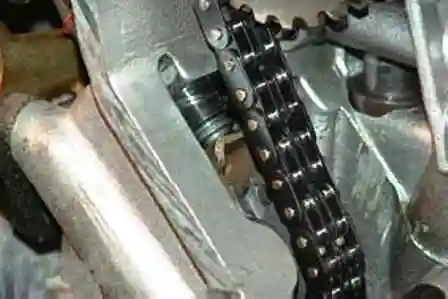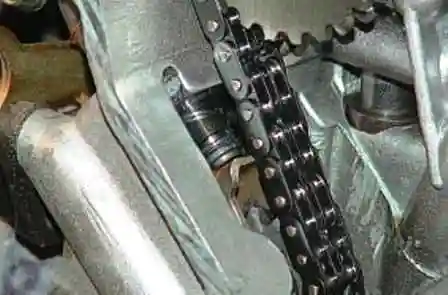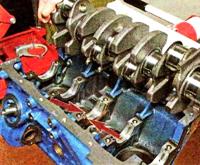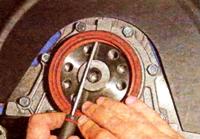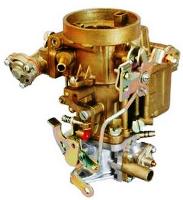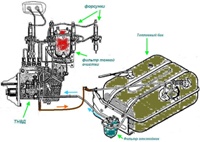The engine has two hydraulic tensioners of the same design - for the upper and lower chain
Because hydraulic tensioners keep the chains constantly taut, regardless of chain stretch or shoe wear, there is no need to adjust chain tension during operation
The hydraulic chain tensioner device is shown in Figure 1.
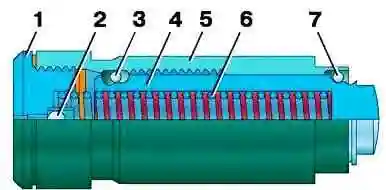
Plunger 4 is installed in housing 5. Spring 6 is inserted into the plunger, which is compressed by screw plug 1.
Return ball valve 2 is installed in the plug.
The plunger is fitted with locking 3 and locking 7 rings.
The figure shows the hydraulic chain tensioner in the non-working ("charged") state, when the retaining ring keeps the plunger from moving.
In order to bring the hydraulic tensioner into working condition ("discharge" it), you need to press the end of the plunger so that the retaining ring moves into the groove of a smaller diameter on the plunger, then under the action of the spring the plunger will move out of the body.
The hydraulic tensioner is installed on the engine in a charged state.
Under the action of a spring and oil flowing through the valve from the engine lubrication system, the plunger presses on the tensioner shoe and keeps the chain taut.
As the chain stretches and the idler shoe wears, the plunger moves further out of the body, the locking ring moves into the next annular groove on the body, preventing the plunger from moving in the opposite direction.
When the chain hits the tensioner shoe (for example, when changing the engine operating mode), the plunger moves back into the housing by the width of the groove for the locking ring. At the same time, he compresses the spring.
In addition, the valve closes and additional damping occurs due to the fact that the oil is squeezed out through the gap between the plunger and the body.
You will need: a 12 wrench, a screwdriver.

Holding the hydraulic tensioner cover (it is pressed from the inside by the tensioner), unscrew the two bolts with a 12 wrench.
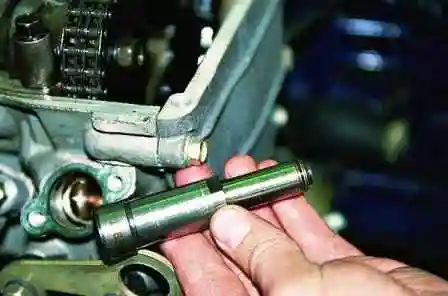
Remove the cover and take out the hydraulic tensioner.
We install the hydraulic tensioner in a "charged" state, lubricating the channel in the block head and, if necessary, replacing the torn gasket.
After installation, we bring the hydraulic tensioner into working condition - “discharge”.
Charging the hydraulic tensioner
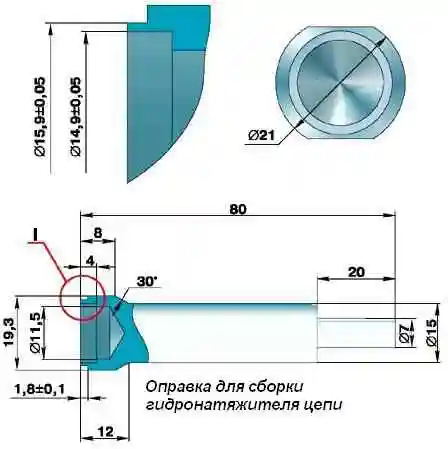
If there is no mandrel for assembling the hydraulic tensioner or it is not possible to manufacture it, you can assemble the tensioner as follows.
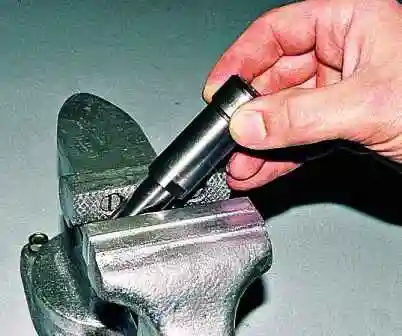
We reduce the vise jaws, leaving a gap of 19 mm between them.
Do not vise the tensioner body.
When disassembling two hydraulic tensioners at once, do not confuse their plunger pairs, as they are matched with a certain clearance.

Having installed the tensioner body in a vise, as in the mouth of a key, with a wide-bladed screwdriver...

Turn out the valve.
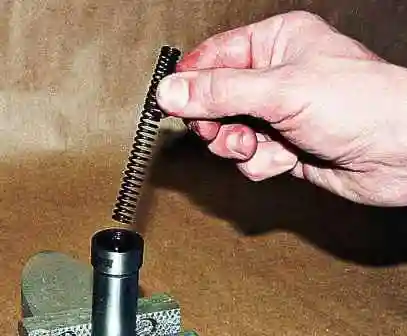
Remove the spring from the body
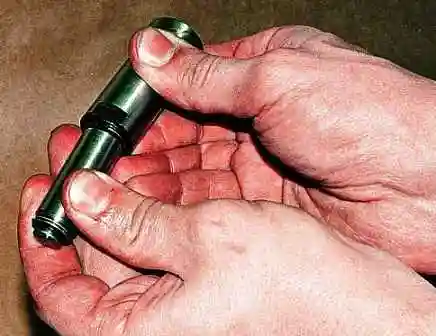
Remove the plunger.
We wash all parts in gasoline or kerosene, blow with compressed air and lubricate with engine oil.
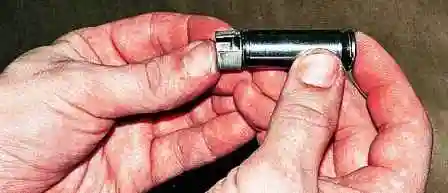
From a steel sheet with a thickness of 0.8-1.0 mm, cut out a strip (10-15 mm wide and 25 mm long).
With round-nose pliers or on a mandrel, bend it into a ring with a diameter like that of a plunger.
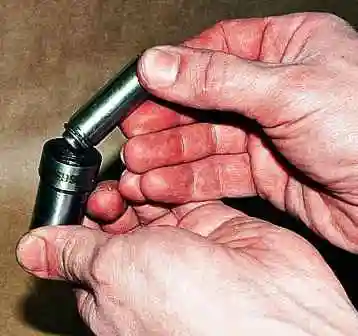
With a manufactured mandrel, we press the spring in the hydraulic tensioner body.
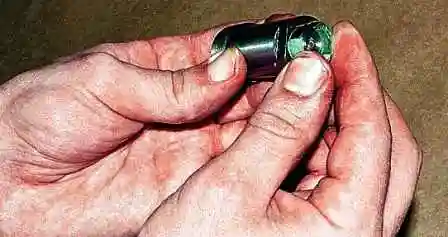
Installing the plunger into the body.
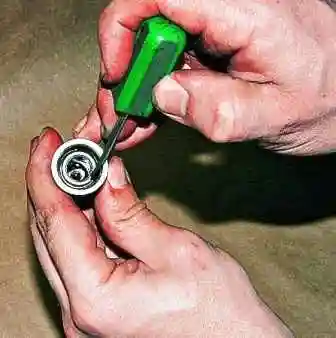
If necessary, use a thin screwdriver to guide the locking ring.

Use a screwdriver to press the bottom of the plunger all the way.
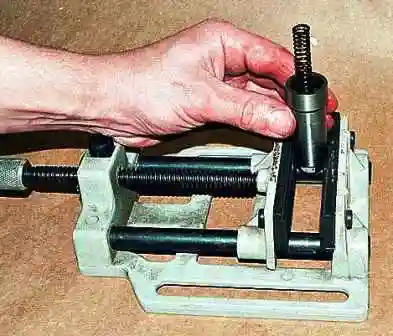
We install the spring into the plunger, and the body itself into a vise.

Overcoming the resistance of the spring, we wrap the valve into the hydraulic tensioner body.
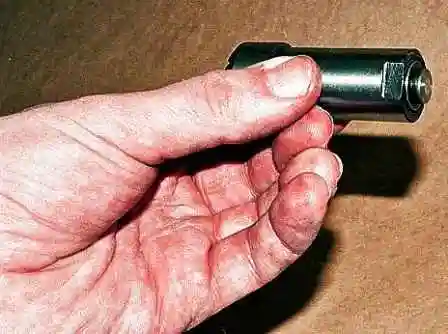
For a properly charged tensioner, the plunger must be fully inserted into the body.
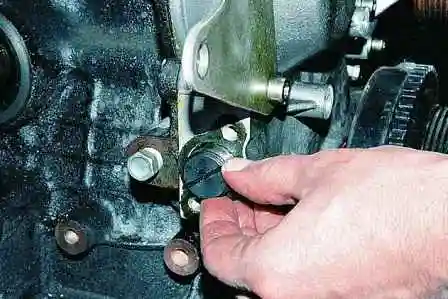
Use a screwdriver to tighten the valve, holding the body in a vise (as in disassembly).
Do not press on the protruding end of the plunger, and after installation in the channel of the head of the block - on the tensioner itself.
Discharging the hydraulic tensioner
After installing the hydraulic tensioner on the engine, it must be brought into working condition - discharged. For this:

Using a 12 key, we unscrew the plug from the hydraulic tensioner cover.
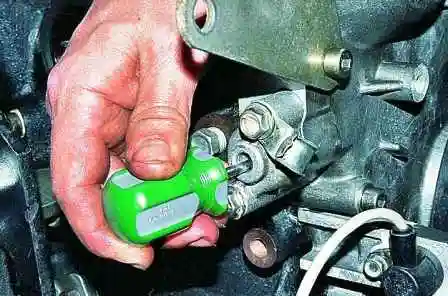
With a screwdriver through the hole, press the tensioner, which, "discharged", will push it out
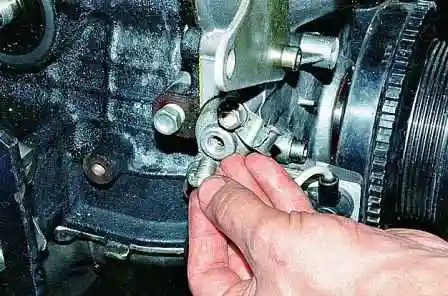
Install the cork in place.
